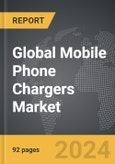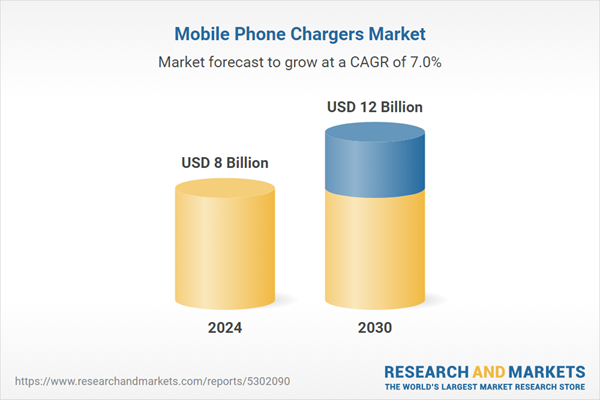Global Mobile Phone Chargers Market - Key Trends and Drivers Summarized
What’s Powering the Evolution of Mobile Phone Chargers?
Mobile phone chargers are essential accessories that keep our smartphones powered and ready for use. These devices function by converting electrical energy from a power source - typically a wall socket, power bank, or even a laptop - into a form that is suitable for charging the battery of a mobile phone. The key component in this process is the transformer within the charger, which steps down the high voltage of AC (alternating current) from the power outlet to the low voltage of DC (direct current) that a phone's battery requires. Additionally, the charging cable, often a USB type, plays a crucial role in delivering this converted energy to the mobile device. In recent years, mobile chargers have evolved to accommodate faster charging speeds, with technologies like Qualcomm’s Quick Charge and USB Power Delivery (USB-PD) enabling significantly reduced charging times. These advancements ensure that users can keep up with their fast-paced lives without long interruptions due to charging. Whether it's a traditional wall charger, a car charger, or a portable wireless charging pad, the necessity for reliable and efficient charging solutions continues to grow alongside the increasing power demands of modern smartphones.What Technological Innovations Are Driving the Next Generation of Mobile Chargers?
The mobile phone charger industry has seen rapid advancements, driven by innovations in power management, efficiency, and convenience. One of the most notable innovations is fast charging technology, which allows mobile phones to be charged in a fraction of the time compared to traditional chargers. Fast charging is made possible by increasing the power output from the charger, typically measured in watts (W), and optimizing the charging circuit within the phone to handle higher currents. Technologies like Qualcomm Quick Charge, USB Power Delivery (USB-PD), and proprietary solutions from companies like Apple and Samsung have revolutionized how quickly devices can reach full battery capacity. Wireless charging is another groundbreaking advancement, offering users the convenience of charging their phones without needing to plug in a cable. Using electromagnetic induction, wireless chargers transfer energy between a charging pad and a phone through magnetic fields, with standards like Qi (developed by the Wireless Power Consortium) ensuring cross-device compatibility. In addition, innovations like GaN (Gallium Nitride) chargers are leading to smaller, more efficient chargers that can handle higher power outputs without overheating, making them ideal for both fast charging and multi-device charging. Foldable, portable solar chargers have also emerged as eco-friendly alternatives, especially in off-grid or outdoor situations, providing users with sustainable charging options.How Are Mobile Phone Chargers Transforming Consumer Behavior and Market Trends?
Mobile phone chargers are no longer just functional tools but have become integral to user convenience, shaping consumer behavior and influencing market trends. The demand for faster charging solutions has changed how consumers perceive and interact with their devices, with many prioritizing fast-charging capabilities when choosing new smartphones or accessories. The growing prevalence of fast chargers bundled with smartphones, or sold separately, has created a shift toward high-power charging technologies like 30W, 65W, or even 100W chargers, particularly for power-hungry devices that support 5G connectivity and advanced features like high-refresh-rate displays. Wireless charging has also gained significant traction, influencing the design of smartphones and public spaces, with many cafés, airports, and cars now offering built-in wireless charging pads for customer convenience. The trend of reducing cable clutter has been another driver of wireless charging adoption, with users seeking the flexibility of simply placing their devices on a charging pad without needing to connect or disconnect cables. Furthermore, eco-conscious consumers are beginning to opt for sustainable charging solutions, such as solar-powered chargers and energy-efficient models that reduce environmental impact. This trend is being bolstered by manufacturers, many of whom are reducing e-waste by no longer including chargers with new smartphone purchases, pushing consumers to either reuse existing chargers or purchase more energy-efficient third-party options. This shift is having a considerable impact on consumer habits, as people become more selective about the chargers they invest in.What Factors Are Fueling the Expansion of the Mobile Phone Charger Market?
The growth in the mobile phone charger market is driven by several factors, each contributing to the rapid expansion and innovation in this space. One of the key drivers is the increasing power consumption of modern smartphones, which have become more powerful with each new generation. Features like high-resolution displays, 5G connectivity, and advanced processing capabilities have led to larger battery sizes and a corresponding need for faster and more efficient charging solutions. As a result, fast charging technologies like USB Power Delivery (USB-PD) and Qualcomm’s Quick Charge are in high demand, as consumers seek chargers that can power their devices in minutes rather than hours. Another critical factor is the widespread adoption of wireless charging, which has gained popularity thanks to the convenience it offers, especially as more devices become Qi-compatible, including not just smartphones but also smartwatches and wireless earbuds. Additionally, the shift towards eco-friendly products and practices is driving growth in the market for energy-efficient chargers and alternative power sources like solar chargers. Many consumers are now looking for sustainable options, and manufacturers are responding by developing more energy-efficient charging technologies that reduce standby power consumption. Another significant growth driver is the increasing trend of multi-device charging, with consumers demanding chargers that can power multiple devices at once - whether via USB hubs or wireless charging stations - which is becoming more important as people juggle smartphones, tablets, wearables, and other electronics. Lastly, the move by smartphone manufacturers to exclude chargers from new smartphone packages, citing environmental concerns, is expected to increase demand for third-party chargers, especially as consumers look for compatible, high-performance alternatives. These technological advancements and changing consumer behaviors are driving the growth of the mobile phone charger market and shaping its future development.Report Scope
The report analyzes the Mobile Phone Chargers market, presented in terms of units. The analysis covers the key segments and geographic regions outlined below.Segments: Segment (Mobile Phone Chargers).
Geographic Regions/Countries: World; United States; Canada; Japan; China; Europe (France; Germany; Italy; United Kingdom; Spain; Russia; and Rest of Europe); Asia-Pacific (Australia; India; South Korea; and Rest of Asia-Pacific); Latin America (Argentina; Brazil; Mexico; and Rest of Latin America); Middle East (Iran; Israel; Saudi Arabia; United Arab Emirates; and Rest of Middle East); and Africa.
Regional Analysis
Gain insights into the U.S. market, valued at $2.1 Billion in 2024, and China, forecasted to grow at an impressive 10.8% CAGR to reach $3.0 Billion by 2030. Discover growth trends in other key regions, including Japan, Canada, Germany, and the Asia-Pacific.Why You Should Buy This Report:
- Detailed Market Analysis: Access a thorough analysis of the Global Mobile Phone Chargers Market, covering all major geographic regions and market segments.
- Competitive Insights: Get an overview of the competitive landscape, including the market presence of major players across different geographies.
- Future Trends and Drivers: Understand the key trends and drivers shaping the future of the Global Mobile Phone Chargers Market.
- Actionable Insights: Benefit from actionable insights that can help you identify new revenue opportunities and make strategic business decisions.
Key Questions Answered:
- How is the Global Mobile Phone Chargers Market expected to evolve by 2030?
- What are the main drivers and restraints affecting the market?
- Which market segments will grow the most over the forecast period?
- How will market shares for different regions and segments change by 2030?
- Who are the leading players in the market, and what are their prospects?
Report Features:
- Comprehensive Market Data: Independent analysis of annual sales and market forecasts in US$ Million from 2024 to 2030.
- In-Depth Regional Analysis: Detailed insights into key markets, including the U.S., China, Japan, Canada, Europe, Asia-Pacific, Latin America, Middle East, and Africa.
- Company Profiles: Coverage of players such as Aigo, Aohai, Arun, Hingyi, Hosiden and more.
- Complimentary Updates: Receive free report updates for one year to keep you informed of the latest market developments.
Some of the 36 companies featured in this Mobile Phone Chargers market report include:
- Aigo
- Aohai
- Arun
- Hingyi
- Hosiden
- LG Electronics
- MC power
- Mipow
- Momax
- PNY
Tariff Impact Analysis: Key Insights for 2025
Global tariff negotiations across 180+ countries are reshaping supply chains, costs, and competitiveness. This report reflects the latest developments as of April 2025 and incorporates forward-looking insights into the market outlook.The analysts continuously track trade developments worldwide, drawing insights from leading global economists and over 200 industry and policy institutions, including think tanks, trade organizations, and national economic advisory bodies. This intelligence is integrated into forecasting models to provide timely, data-driven analysis of emerging risks and opportunities.
What’s Included in This Edition:
- Tariff-adjusted market forecasts by region and segment
- Analysis of cost and supply chain implications by sourcing and trade exposure
- Strategic insights into geographic shifts
Buyers receive a free July 2025 update with:
- Finalized tariff impacts and new trade agreement effects
- Updated projections reflecting global sourcing and cost shifts
- Expanded country-specific coverage across the industry
Table of Contents
Companies Mentioned (Partial List)
A selection of companies mentioned in this report includes, but is not limited to:
- Aigo
- Aohai
- Arun
- Hingyi
- Hosiden
- LG Electronics
- MC power
- Mipow
- Momax
- PNY
Table Information
| Report Attribute | Details |
|---|---|
| No. of Pages | 92 |
| Published | April 2025 |
| Forecast Period | 2024 - 2030 |
| Estimated Market Value ( USD | $ 8 Billion |
| Forecasted Market Value ( USD | $ 12 Billion |
| Compound Annual Growth Rate | 7.0% |
| Regions Covered | Global |









